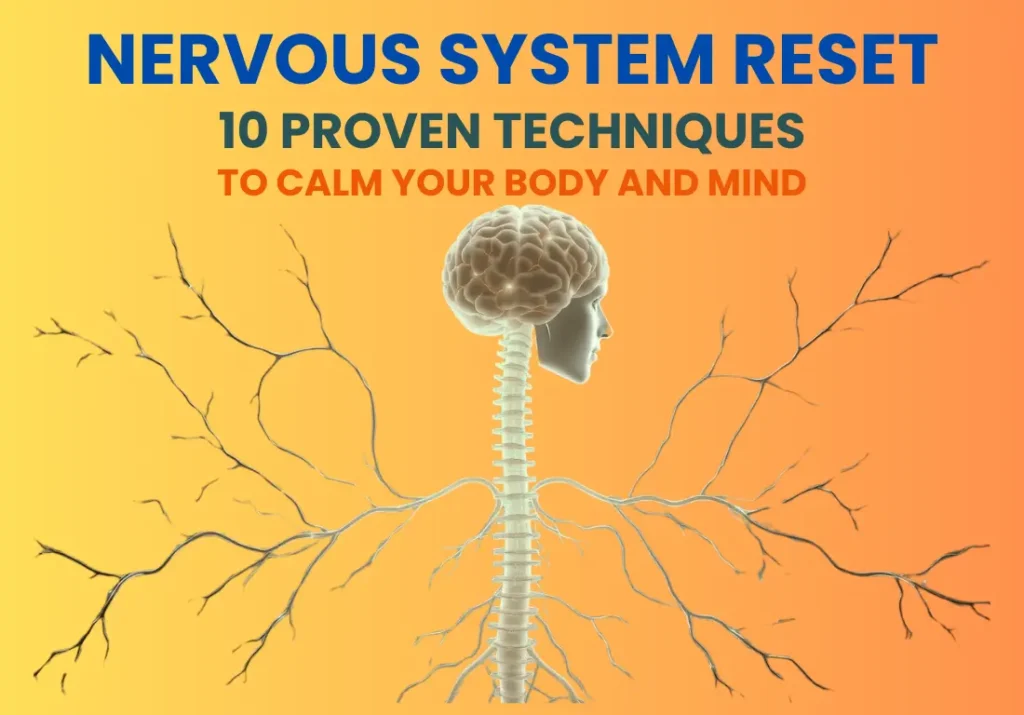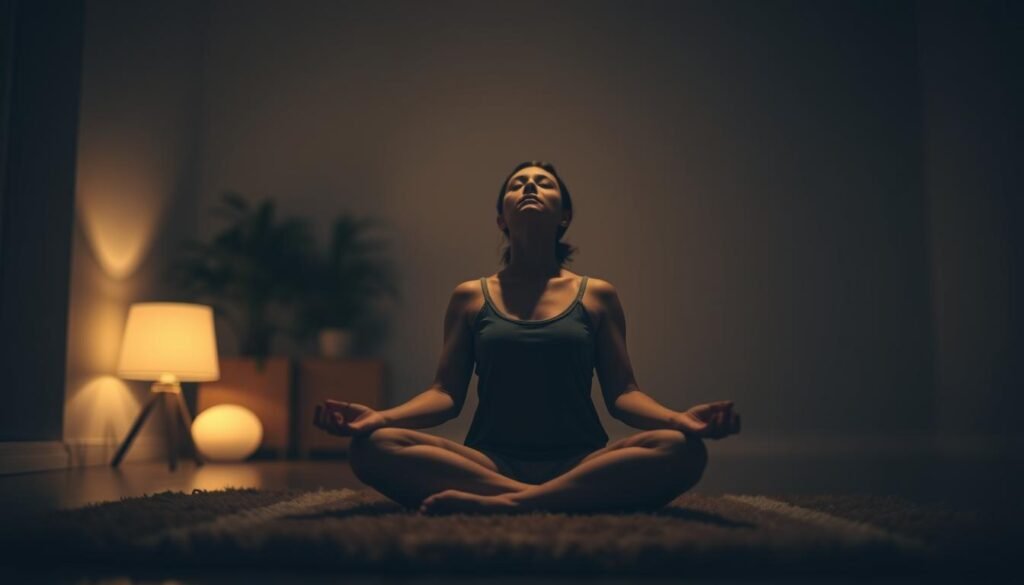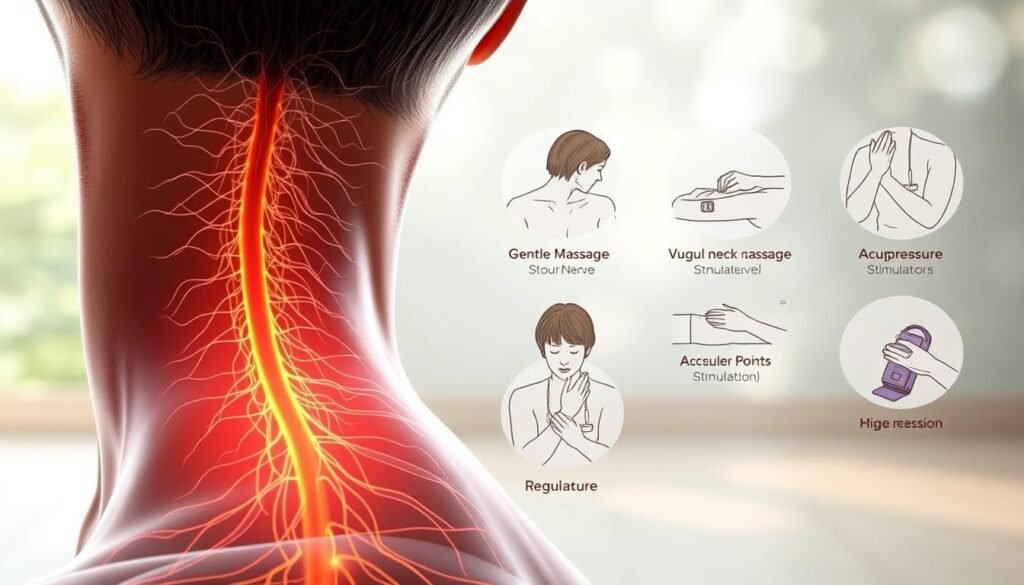Have you ever felt like your body is stuck in overdrive—tense, overwhelmed, and unable to relax no matter what you do? You’re not alone. Millions of people silently struggle with a dysregulated nervous system, often without realizing it. Experts say that chronic stress, trauma, or even constant screen time can keep your body locked in “fight-or-flight” mode, leading to anxiety, fatigue, and burnout.
But here’s the good news: your nervous system isn’t broken—it’s just overworked. And you can reset it.
In this guide, you’ll learn 10 science-backed nervous system reset techniques that help you feel calmer, clearer, and more in control—naturally and without medication. These tools are simple, effective, and easy to start today.
Here’s what you need to know to finally bring your body and mind back into balance..

Understanding Your Nervous System and Why It Needs Resetting
To feel calm and well, you need to know about your nervous system. It’s a complex network that controls your body’s functions. When it’s not working right, you might feel stressed or uncomfortable.
The Autonomic Nervous System: Sympathetic vs. Parasympathetic
The autonomic nervous system (ANS) controls your body’s actions without you thinking about them. It has two parts: the sympathetic nervous system (SNS) and the parasympathetic nervous system (PNS). The SNS gets you ready to face danger or stress. The PNS helps you relax and recover.
Keeping these systems in balance is key to staying healthy. Too much SNS activity can make you anxious. But a strong PNS helps calm you down.
Signs Your Nervous System Is Dysregulated
If your nervous system is off, you might notice some symptoms. These include:
- Chronic stress and anxiety
- Insomnia or irregular sleep patterns
- Digestive issues
- Fatigue and lack of energy
- Difficulty concentrating
Spotting these signs is the first step to fixing your nervous system.
The Science Behind Polyvagal Theory
The polyvagal theory, by Dr. Stephen Porges, sheds light on how your nervous system reacts to threats. It shows how the ANS, and the vagus nerve, are key in this process. The theory says your body’s stress response includes fighting, fleeing, and even social behaviors.
Learning about polyvagal theory helps you understand your nervous system better. It shows how to find calm and safety in different situations.
The Science of Nervous System Reset and Its Benefits

Learning about nervous system reset can boost your mental and physical health. It shows how stress impacts your body and brain. It also talks about the benefits of regular reset practices.
How Stress Affects Your Body and Brain
Chronic stress messes with your nervous system, affecting your body and brain. Stress triggers your “fight or flight” response, releasing hormones like cortisol and adrenaline. These hormones help you react to threats but can harm your health if always present.
Using nervous system reset techniques can lessen stress effects. It helps your body and brain regulate stress better.
The Physiological Process of Regulation
The physiological process of nervous system regulation is complex. It involves the sympathetic and parasympathetic branches of the autonomic nervous system. The sympathetic system is for “fight or flight,” while the parasympathetic system helps you relax and recover.
Reset practices like deep breathing and exercise can help balance these systems. This leads to better nervous system regulation and stress reduction.
Long-term Benefits of Regular Reset Practices
Adding reset practices to your life offers many long-term benefits. You’ll see better emotional control, stress resilience, and overall well-being. Regular use of self-regulation techniques improves body awareness, mood, and stress handling.
- Improved emotional regulation
- Enhanced resilience to stress
- Better overall well-being
- Greater body awareness
- Improved mood
By grasping the science of nervous system reset and making it a daily habit, you can keep your nervous system healthy. This promotes long-term well-being.
Deep Breathing Techniques for Immediate Calm

When you’re stressed, deep breathing can help right away. It calms your body and mind. It’s a simple way to feel better and less anxious.
Deep breathing helps your body relax. It works by calming your nervous system. Using these techniques daily can make you feel less stressed and better overall.
Box Breathing Method
The box breathing method is also called square breathing. You breathe in for 4 counts, hold for 4, breathe out for 4, and hold again for 4. This makes a “box” shape with your breath.
To do box breathing, sit straight with your back. Close your eyes and breathe in through your nose for 4 counts. Hold for 4 counts, feeling calm. Breathe out through your mouth for 4 counts, then hold again for 4. Keep doing this a few times.
Diaphragmatic Breathing
Diaphragmatic breathing, or belly breathing, uses your diaphragm. It’s better than shallow chest breathing. It can slow your heart, lower blood pressure, and relax you.
To practice, put one hand on your belly and the other on your chest. Breathe in deeply through your nose, letting your belly rise. Your chest shouldn’t move. Breathe out through your mouth, letting your belly fall. Do this a few times.
4-7-8 Breathing Technique
The 4-7-8 technique, or the “relaxation breath,” is breathing in for 4 counts, holding for 7, and exhaling for 8. It can slow your heart and relax you.
To try it, sit straight and close your eyes. Keep your tongue behind your teeth. Breathe in for 4 counts, hold for 7, and exhale for 8, making a soft sound. Do this up to 3 times.
Adding these deep breathing techniques to your day can help you manage stress better. Regular use can balance your nervous system and bring calm to your life.
| Breathing Technique | Description | Benefits |
|---|---|---|
| Box Breathing | Inhale, hold, exhale, hold for counts of 4 | Reduces stress, improves focus |
| Diaphragmatic Breathing | Breathe deeply into the diaphragm | Promotes relaxation, lowers blood pressure |
| 4-7-8 Breathing | Inhale for 4, hold for 7, exhale for 8 | Slows heart rate, promotes relaxation |
Vagus Nerve Stimulation: The Gateway to Regulation

Your vagus nerve is key to your nervous system’s health. It helps control heart rate, digestion, and breathing. Stimulation can make you feel calmer and less stressed.
Cold Exposure and Cold Water Immersion
Cold exposure and cold water immersion can wake up your vagus nerve. When you’re cold, your body starts special processes. Cold water immersion boosts neurotransmitters that calm your nervous system.
Start with cold showers or short cold water dips. Begin with temperatures you can handle. Then, slowly make them colder to get used to it.
Humming, Chanting, and Gargling
Humming, chanting, and gargling can also wake up your vagus nerve. These actions make the muscles in your throat work. This can improve how well your nervous system works.
Try humming or chanting during meditation or before bed. Gargling with water can also help your vagus nerve.
Facial and Neck Exercises for Vagal Tone
Exercises for your face and neck can boost vagal tone. Facial massage, neck stretches, and yoga poses can help. They make your vagus nerve work better.
Try gentle face massage or neck stretches. Doing these regularly can balance your nervous system.
Mindfulness and Meditation Practices

Mindfulness and meditation can calm your body and mind. They help regulate your nervous system and improve emotional well-being. They also reduce stress.
Mindfulness means being fully present in the moment. Meditation helps focus your mind. Both improve physical and mental health.
Body Scan Meditation
Body scan meditation involves focusing on your body parts. Start from your toes and go up to your head. It releases tension and promotes relaxation.
To do body scan meditation, find a quiet spot. Close your eyes and breathe deeply. Focus on each part of your body, noticing sensations and thoughts without judgment.
Present Moment Awareness
Present moment awareness is about being mindful in daily life. It means noticing your thoughts and feelings without getting caught up in them. This helps you stay calm in tough times.
To practice, focus on your daily tasks. Notice the sensations, sights, and sounds around you. For example, pay attention to the taste and smell of your food when eating.
Loving-Kindness Meditation for Emotional Regulation
Loving-kindness meditation, or metta meditation, builds love and compassion. It helps with emotional regulation and understanding.
To practice, sit comfortably, close your eyes, and breathe deeply. Start by saying kind things to yourself, like “May I be happy, may I be healthy, may I be at peace.” Then, say these things to others, including friends and those you may not get along with.
Adding these practices to your daily life can improve emotional regulation and reduce stress. Regular practice leads to a balanced nervous system and more calm in your life.
Somatic Practices for Releasing Stored Tension
Tension builds up in our bodies from stress. Somatic practices help release it. They focus on the mind-body connection, making you aware of your body’s sensations.
Adding somatic practices to your routine can reduce stress and anxiety. It also improves emotional control and overall well-being. These practices are great for those with trauma or chronic stress.
Tension and Release Exercises
Tension and release exercises tense and relax muscles. This helps you find and release tension. Start by sitting or lying down comfortably.
- Begin by tensing your toes, holding for a few seconds, and then releasing.
- Gradually work your way up through the body, tensing and releasing each major muscle group.
- Pay attention to how your body feels as you release tension, noticing any changes in sensation or relaxation.
Somatic Experiencing Techniques
Somatic Experiencing (SE) was developed by Dr. Peter Levine. It focuses on releasing physical tension from trauma. SE involves noticing bodily sensations and letting them unfold naturally.
To practice SE, find a safe and comfortable space. Then, focus on areas of tension or discomfort in your body. Let yourself fully experience these sensations without trying to change them.
- Notice the sensation, its location, and its characteristics.
- Allow the sensation to change or evolve on its own, without forcing it.
- Continue this process until you feel a sense of release or relaxation.
Gentle Movement and Shaking
Gentle movement and shaking release stored tension. These practices let your body release pent-up energy. Stand with your feet shoulder-width apart and let your body shake naturally.
Practices like qigong or tai chi are also helpful. They combine slow movements with deep breathing, promoting relaxation and reducing tension.
By adding these somatic practices to your daily routine, you can start releasing tension. This promotes overall well-being.
Grounding Techniques to Anchor Your Nervous System
Grounding techniques help stabilize your nervous system. They make you feel safe and calm. These practices keep you in the present, reducing stress and anxiety.
By adding grounding techniques to your day, you can better manage your nervous system. This improves your overall well-being.
The 5-4-3-2-1 Sensory Grounding Method
The 5-4-3-2-1 sensory grounding method is simple yet powerful. It helps you stay grounded in the present. Here’s how to do it:
- Notice 5 things you can see around you.
- Acknowledge 4 things you can touch or feel, like your feet or the air.
- Identify 3 things you can hear.
- Recognize 2 things you can smell.
- Notice 1 thing you can taste.
This method shifts your focus to your surroundings. It calms your nervous system.
Earthing and Nature Connection
Earthing involves touching the Earth’s surface to feel calm. Walking barefoot or sitting on the ground is helpful. Dr. Gaetan Chevalier says, “
When you touch the Earth, you get its electrons. These can neutralize harmful free radicals and reduce inflammation.
Being in nature also grounds you. Activities like walking in parks or hiking can reduce stress and improve mood.
Physical Grounding Through the Feet
Physical grounding through the feet is very effective. Try standing or walking barefoot. Pay attention to how your feet feel on the ground.
You can also:
- Press your feet firmly into the floor or ground.
- Notice how your weight is distributed on your feet.
- Imagine roots or a strong connection from your feet to the earth.
Focusing on your feet’s sensations helps you stay present. It calms your nervous system.
Movement-Based Approaches to Nervous System Reset
Movement and the nervous system are closely linked. Practices like movement help reset and balance your nervous system. This approach improves your overall health.
Yoga Poses for Nervous System Balance
Yoga is great for balancing your nervous system. Some poses calm your mind and regulate your nervous system. Child’s Pose, Cat-Cow Pose, and Legs Up the Wall Pose are good for this.
These poses lower stress and anxiety. They activate the parasympathetic nervous system, which brings calm. Regular yoga can improve emotional control and balance your nervous system.
Trauma Release Exercises (TRE)
TRE exercises help release deep tension and trauma. Developed by David Berceli, TRE uses simple exercises to release tension. This promotes nervous system balance.
“TRE allows the body to return to its natural state of balance and resilience, promoting overall well-being and reducing the impact of stress and trauma.”
Adding TRE to your routine can release tension. It improves emotional strength and boosts nervous system health.
Gentle Walking and Rhythmic Movement
Gentle walking and rhythmic movement are key for nervous system reset. Activities like walking or dancing can regulate your nervous system. They make you feel safe and connected to your body.
Rhythmic movement calms the brain and boosts well-being. Regular gentle walking or rhythmic activities reduce stress, improve mood, and enhance nervous system function.
Sound and Music Therapy for Neural Calming
You can use sound and music to calm your nervous system. Sound and music therapy help relax and reduce stress.
Binaural Beats and Sound Frequencies
Binaural beats and sound frequencies change your brainwaves. They help you relax. Listening to binaural beats can make your brainwaves like alpha or theta waves.
- Binaural Beats: Listening to binaural beats through headphones is soothing. Your brain processes the difference between the two frequencies.
- Sound Frequencies: Certain sound frequencies, like Solfeggio, are believed to heal. They help reduce stress and promote relaxation.
Singing and Vocal Toning
Singing or vocal toning calm your nervous system. These practices release emotions and stimulate the vagus nerve. This promotes relaxation.
Vocal toning makes specific sounds to release tension. Regular practice improves emotional control and brings calm.
Listening to Calming Music
Calming music helps calm your nervous system. Soothing music with a slow tempo reduces stress and anxiety. It promotes relaxation.
- Choose music with a consistent and calming melody.
- Consider nature sounds or classical music for their calming effects.
- Experiment with different genres to find what works best for you.
Using sound and music therapy daily can balance and calm your nervous system.
Creating Daily Rituals for Long-Term Nervous System Health
Daily rituals are key for nervous system health. They help you feel better and handle stress better. By doing the same things every day, you can improve your well-being.
Morning Routines for a Regulated Start
Starting your day right is important for a balanced nervous system. Try meditation, deep breathing, or yoga in the morning. For example, meditate for 10 minutes then do some yoga.
Here are some morning habits to boost your nervous system:
- Mindfulness meditation
- Deep breathing exercises
- Gentle yoga or stretching
- Journaling or reflection
Midday Reset Practices
It’s important to take breaks and reset your nervous system during the day. Midday reset practices can reduce stress and boost productivity. Try a short walk, muscle relaxation, or fresh air.
| Midday Reset Technique | Benefits |
|---|---|
| Short walk | Improves circulation, reduces muscle tension |
| Progressive muscle relaxation | Reduces physical stress, promotes relaxation |
| Deep breathing exercises | Calms the mind, reduces stress hormones |
Evening Wind-Down Protocol
An evening wind-down is important to tell your nervous system it’s time to relax. Try reading, a warm bath, or gentle stretches. Stay away from screens and exciting activities before bed.
Here’s how to improve your evening routine:
- Dimming lights to signal the body that it’s time to sleep
- Engaging in relaxing activities like reading or listening to soothing music
- Avoiding caffeine and heavy meals close to bedtime
Adding these daily rituals to your routine can greatly improve your nervous system health. Start small and build up for lasting benefits.
Conclusion: Your Path to a Balanced Nervous System
Resetting your nervous system is a journey. It involves understanding its details and using different techniques for balance. Deep breathing, vagus nerve stimulation, mindfulness, and somatic practices help regulate it.
Getting a balanced nervous system takes daily effort. It means doing things every day that help you feel better emotionally and stay strong. Morning routines, midday resets, and evening calm-downs keep your nervous system healthy.
Keep going on your journey to a balanced nervous system. Remember, being consistent and patient is important. By making these habits part of your life, you can improve your health for the long term.
FAQs
What are the symptoms of a dysregulated nervous system?
Common symptoms include anxiety, panic attacks, fatigue, digestive issues, brain fog, and sleep disturbances. You may also feel constantly on edge, emotionally numb, or easily overwhelmed by stress.
How do you reset your nervous system fast?
Quick techniques include deep breathing, cold exposure, humming, or grounding exercises. These activate the vagus nerve to calm your body and shift out of fight-or-flight mode.
Can you reset your nervous system in 30 seconds?
Yes, certain practices like a physiological sigh (double inhale, long exhale) or cold splash on the face can trigger a fast nervous system reset in under a minute.
What are the best nervous system reset exercises?
Gentle yoga, somatic shaking, walking in nature, and slow stretching help release stress and restore nervous system balance. Consistency is key for long-term regulation.
How do you heal a dysregulated nervous system naturally?
Healing involves breathwork, mindful movement, good sleep, a nutrient-rich diet, and activating the vagus nerve through daily practices. Small steps done regularly lead to lasting results.
How long does it take to reset your nervous system?
It varies. Some people feel relief in minutes with grounding or breathwork, while deeper healing from chronic dysregulation can take weeks or months with daily practice.
What is a nervous system reset therapy?
This includes somatic therapies like EMDR, trauma-informed yoga, craniosacral therapy, or vagus nerve stimulation. These approaches help your body process trauma and regain regulation.
Are there any nervous system reset devices?
Yes, devices like vagus nerve stimulators, PEMF mats, or wearable biofeedback tools support nervous system regulation. However, results vary and should complement holistic practices.
Does meditation reset your nervous system?
Yes, meditation calms the mind and body, lowers cortisol, and enhances vagal tone. Even 5–10 minutes of mindful breathing can support nervous system reset.
Can massage reset your nervous system?
Massage therapy reduces muscle tension and stimulates the parasympathetic nervous system. It’s especially helpful for releasing stored stress and promoting relaxation.
What’s the role of the vagus nerve in resetting the nervous system?
The vagus nerve is the main driver of the parasympathetic response. Stimulating it through breath, voice, cold, or touch helps your body switch from stress to calm.
Is yoga effective for nervous system reset?
Yes, gentle yoga poses, especially when combined with slow breathing, activate the parasympathetic system. Restorative and trauma-informed yoga are ideal for nervous system healing.
What is nervous system regulation vs reset?
Regulation is your body’s ability to stay balanced in daily life. A reset helps bring the system back to baseline after stress or trauma has knocked it out of balance.
Can grounding help reset your nervous system?
Yes, grounding techniques like walking barefoot, touching nature, or feeling textures can calm the brain and body. They are especially useful during overwhelm or anxiety.
How do I know if my nervous system is regulated?
When regulated, you feel calm, present, able to think clearly, and respond—not react—to stress. Your heart rate and breath are steady, and you can enjoy social connection.
Do retreats help with nervous system healing?
Yes, nervous system reset retreats offer immersive healing with tools like breathwork, somatics, and trauma-informed care. They can jumpstart deeper healing if guided safely.

